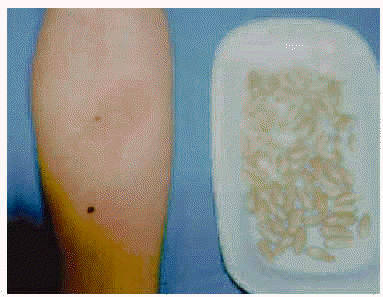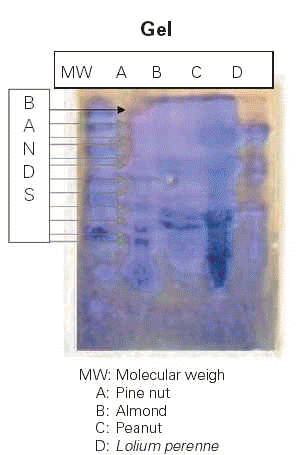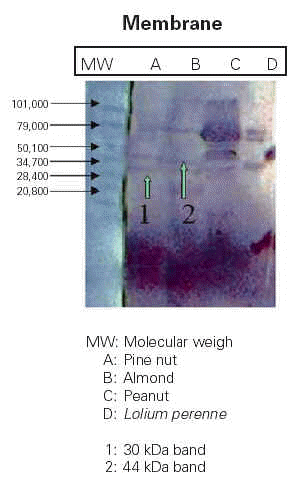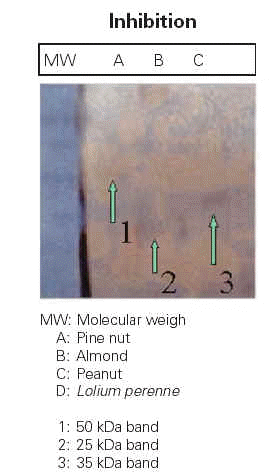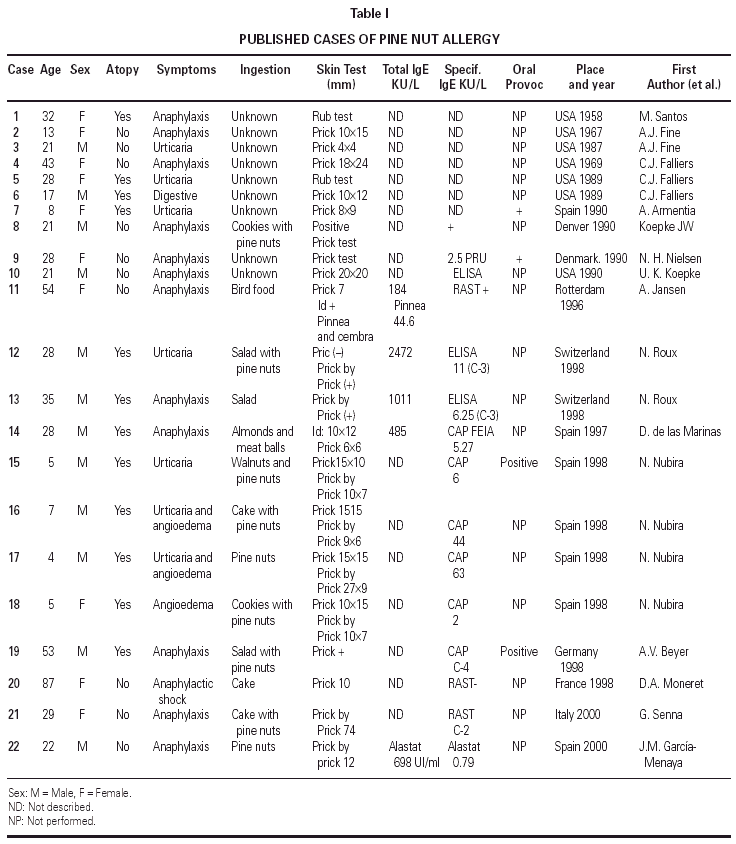INTRODUCTION
It is estimated that the prevalence of food allergy ranges from 1.4 % (1) to 2.4 % (2) among adults, and from 0.3 % to 7.5 % among children, and it is around 10 % among atopic individuals (3).
About 3.6 % of the patients who came to an Allergology service have food sensitisation.
Pine nut is the fruit of the Pinus pinea L. belonging to the Pinaceae family, of the gymnosperm class. It is also called Pinus sativa Quer. and Pinus domestica Mathiol. It blooms from March to May, and in Europe it can be found along the Mediterranean basin where it was spread by the Romans, occupying nowadays 2.84 % of the woodland. In Spain the areas of greatest incidence are Huelva, Sevilla and Cadiz, followed by the Northern plateau, appearing in Valladolid (where it is exported as fruit tree), in Zamora, Ávila and Segovia, apart from other areas in Spain (4).
Because of the case report we review the literature and assess the possible existence of common allergens by immunoblotting.
CASE REPORT
Ten year old boy diagnosed previously of seasonal rhinoconjunctivitis for grass and olive pollen sensitisation.
The patient is under treatment with sublingual immunotherapy to grass pollen since September 2000, presenting a good evolution and staying with no nasal or conjunctival symptoms.
The patient comes to our clinic presenting abdominal pain; pharyngeal, retroauricular, axillar and toe pruritus; and labial and palpebral angioedema, after eating caramel pine nut with good response to the parenteral treatment with methilprednisolone and dexclorphenhiramine.
RESULTS
Blood tests and erythroctye sedimentation were within normality. Skin prick tests were positive to almond (5 mm) and peanut (5 mm), and negative to hazelnut, sunflower seed, walnut, pistachio and pine (pinnus spp. Prick by prick test was positive to pine nut (12 mm) (fig. 1). Specific IgE by CAP FEIA (Pharmacia, Uppsala, Sweden) to pinnus edules: 8.32 kU/l, Pinnus strobus: negative, lolium: 21.6 kU/l and olive: 5.71 kU/l. Total IgE value was 64.5 kU/l. Basophil activation test was positive to pine nut (80.7 %) and peanut (87 %), and negative to pine and almond. Histamine release to pine nut was 38.3 %, to peanut 40.43 %, to almond 2.13 % and to pinnus sp. 0 %, basal histamine 2.88 ng/ml, total histamine 78.21 ng/ml; anti IgE 38.38 %.
Figure 1.--Prick-Prick to pine nut.
Immunoblotting by SDS-PAGE was performed using pine nut, almond and peanut extract in polyacrylamide gel (fig. 2), the gel revealed about 12 proteic bands with molecular weighs from 20 to 140 kDa (fig. 3). In the nitrocellulose membrane, we observed bands that react with the patient's specific IgE, especially the 30 and 44 kDa ones. Subsequently, we performed immunoblotting inhibition, by incubating the patient serum with peanut extract for 24 hours. Afterwards another immunoblotting was performed using pine nut, almond and lolium extracts. The result was that most bands disappeared especially the 30 and 44 kDa (fig. 4), remaining for pine nut a 50 kDa band, for almond a 25 kDa band and for Lolium a 35 kDa band.
Figure 2.--Immunoblotting gel to pine nut, almond and peanut.
Figure 3.--Immunoblottin membrane to pine nut, almond and peanut.
Figure 4.--Inhibition immunoblotting to pine nut, almond and peanut.
DISCUSSION
We find in the literature several publications on food allergy to this fruit, and a total of 21 case reports (table I).
Koepke JW et al (5) in 1990 proved by electrophoresis 30 proteic bands, three of which were in the range of 66 to 68 kDa. In 1996, the existence of cross reactivity between pinus pinea and pinus cembra was described for the first time in a patient who presented allergic reaction to pine nuts after eating parrot's food (6). Roux et al (7) in 1998 described the case of a patient with systemic reaction to pine nut who previously suffered from sensitisation to almond.
De las Marinas et at (8) presented in 1998 one patient with previous demonstrated sensitisation to almond, who had suffered severe anaphylaxis after eating pine nuts. They proved the existence of 12 antigenic bands of molecular weighs between 17 and 133 kDa and finding a common 50 kDa band between almond and pine nut with inhibition blotting and confirmed by inhibition CAP. Nubira et al (9) in 1998 described four cases of allergy to pine nuts among children aged 12 months to 6 years, with the particularity that none of them was aware of having eaten pine nuts before. They concluded that due to the great disguised consumption of this nut in our country, the prevalence of allergic reactions was probably greater here and happened at an earlier age. Moneret-Vautrin et al (10) in 1998 published a case of allergy to walnut and pine nut stimulated by the increase of vascular permeability and the vasodilatation produced by an angiotensin converting enzime inhibitor. In 2000 anaphylaxis by pine nut and cross reactivity to pine pollen proteins is proven (11). In an extract of pine pollen the existence of several 8 to 90 kDa bands is demonstrated, as well as an 8 to 11 kDa band. Subsequently, García-Menaya et al. (12) detected through SDS-PAGE a new 17 kDa monoclonal band not described previously.
Out of the 22 cases of allergy to pine nuts found in the literature, eleven were atopic. Regarding the symptoms, only one patient had anaphylactic shock, 12 had anaphylaxis, including the present case, and the other ten had urticaria with or without angioedema. In most cases the nuts were disguised with other foods, or the patient ignored having eaten it before. Only in four cases the reaction is due to a direct ingestion, like in our case.
Regarding the diagnostic tests, prick test was positive in all the patients, seven of them underwent also prick by prick tests, and two rub test. We can therefore state that skin test is reliable in this pathology. Specific IgE levels went from class 2 to class 6. Oral provocation test had to be done in four patients, two of them children, and the result was positive in all of them. In our case, the evident symptoms clearly advised against it.
Up to now, we have found no cross reactivities described between peanut and pine nut. In our results, the fact that the 30 and 44 kDa bands disappear in the inhibition immunoblotting demonstrates the existence of these common antigenic proteins between pine nut and peanut.
The finding described makes it necessary to avoid both foods in these patients' diet, even though the symptoms appear only with one of them.
It is interesting to highlight the apparent lack of cross reactivity with almond unlike the case described in 1998 (8). Nevertheless our patient was advised to avoid it as well as peanuts.
Cross reactivity with Lolium could not be demonstrated in this patient, since in the inhibition immunoblotting the 30-44 kDa bands remained.




